
 |
|
|
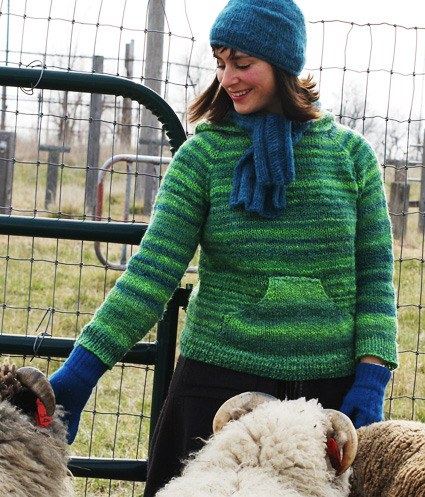
Sometimes when I buy or make fiber, I know exactly what it will become, and spin the yarn accordingly. Other times, I just let the fiber spin itself. For those occasions, it’s great to have some all-purpose recipes you can fall back on. This seamless hoodie is just such a recipe. I’ve included a traditional pattern, written for a specific weight (worsted) and with specific sizes, but I’ve also included the general recipe, so you can knit it a little more freely, to the fit and length that suit your yarn or mood. Make it longer or shorter, with different edges, with or without the pocket. Once you get a feel for the basic pattern, you’ll see it really it works at any gauge and fit you like, and guidelines are given at the end for adapting to different weights. Like all top-down raglans, the charm of this is that you can try it on as you go. Sporto starts with the hood. From there, you pick up sts and work down to your pits with raglan increases, then work the torso and the sleeves and finally, the kangaroo pocket. And since the sleeves and pocket come at the end, if you run out of yarn, you can simply shorten the sleeves or skip the pocket and be no worse off for your effort. Sporto is a basic, any-size, unisex pattern that lends itself to personalization with shaping, edging or stitchwork. The fit as written is like a t-shirt--relaxed but not too baggy. If you prefer more of a roomy sweatshirt fit, hop up a size or two, keeping in mind that you might follow the length guidelines for your usual size. I’ve given yardage for a light to medium worsted yarn. The bright green sample is one ply of a brightly-dyed hand-dyed Art Club combed top plyed with a solid heather combed top (Art Club Succulent); the continuous solid ply softens the color shifts and unifies the whole. The murky green sample was a two-ply spun randomly from a Decadent Fibers Jelly Roll batt. I spun it without direction, then plied it to itself. Afterwards, I eyeballed the colors to re-order the skeins so I believe they proceed as they were plied. How much fiber you need will depend on how you spin, but on average, you’ll need a pound and a quarter spun as worsted for up to a medium, then an extra quarter to half a pound from each size up from there. If you’re spinning bulkier, you’ll need more fiber for the same size. |
||

|
Tweet
|
|
|
SIZE |
|
FINISHED MEASUREMENTS |
| MATERIALS Fiber: Pattern version [shown above] Recipe version [shown below] Recipe version
Drafting Method: Recipe version Recipe version Tools |
|||||
|
GAUGE |
Pattern version Recipe version |
|
PATTERN NOTES |
|
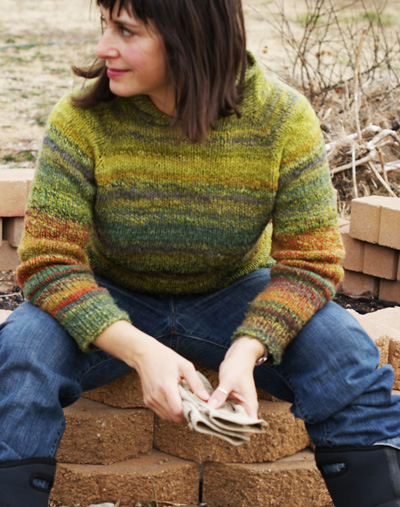 I’ve given specific sizing information, but I really do encourage you to use that as a rough guide and to try the sweater on to determine your size. The strength of this recipe is that it really eliminates the need for a strict pattern and works itself to your own body. The recipe version [shown at right] uses a different gauge yarn with the general recipe below (same as the pattern, but written in general terms). Instead of switching to smaller needles and working rib, I used the same size needles, started a bit sooner, and worked a lace rep at edge of hood, hem, and cuffs. PATTERN NOTES |
|
DIRECTIONS 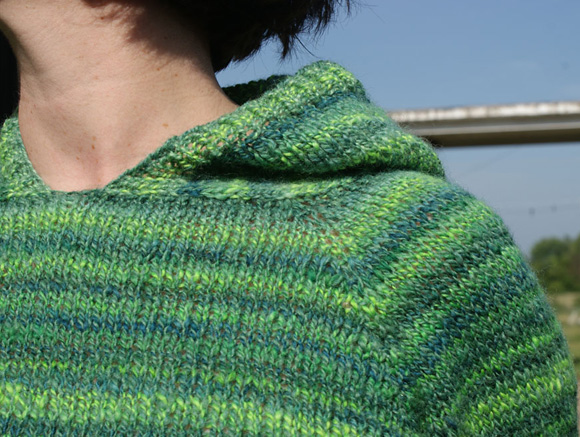
Hood With larger needles, CO 16[16, 16, 16, 20, 20, 20] sts. Row 1 [RS]: Sl 1, knit to end. Row 2 [WS]: Sl 1, purl to 1 st from end, k1. Rep Rows 1 and 2 5 times. Inc Row [RS]: Sl 1, M1, knit to 1 st from end, M1,
k1. 2 sts inc Without turning work, pick up and knit 1 st through the top loop only of each of the slipped sts along the side. Turn work, and knit back up side and across top. Without turning work, pick up and knit 1 st through the top loop only of each of the slipped sts along the other side. Turn work, purl to end. Work in St st until piece measures 7[7, 7, 7, 8, 8, 8] inches from pick up row, ending with a RS row. Change to smaller needles and work in k1, p1 rib for 1 inch. BO in patt, leaving last st live. Yoke Join in the rnd. K14[14, 14, 14, 16, 16, 16], pm, k16[16, 16, 16, 18, 18, 18], pm, k28[28, 28, 28, 32, 32, 32], pm, k16[16, 16, 16, 18, 18, 18], pm, k14[14, 14, 14, 16, 16, 16]. NOTE: Don’t place a marker here, at center front--it can lead to confusion when working the raglan increases. Next Rnd: Knit. Divide for Sleeves Center Back Shaping (optional, shown at right): Dec Rnd: Pm at center back. Knit to 2 sts before marker,
ssk, slip marker, k2tog, knit to end. 2 sts dec Inc Rnd: Knit to 1 st from marker, M1, k1, slip marker,
k1, M1, knit to end. 2 sts inc 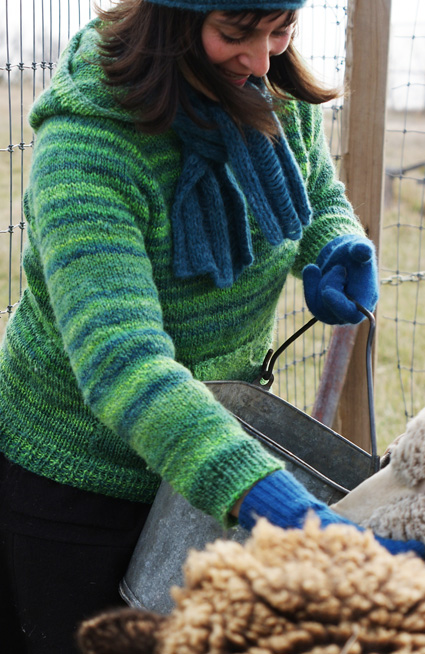 Work in St st, with or without above shaping as desired, until piece measures 12[13, 14, 15, 16, 17, 17] inches from sleeve division or 2 inches shorter than desired length. Change to smaller needles. Work in k1, p1 rib for 2 inches. BO in patt. Sleeves Kangaroo Pocket Decide how far up you want the bottom of your pocket to be (I chose about half an inch above the end of the ribbing) and, with a contrasting yarn and a yarn needle, thread a guideline through the row just below the future pocket bottom. 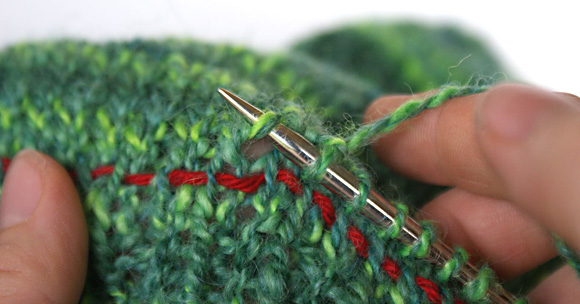
Next Row [WS]: P2tog, then purl across. At the end of the row, pick up the next st in the row above as before. Turn. Next Row [RS]: Ssk, then knit across; at the end of the row, pick up the next st in the row above as before (above the last st, working up the side of the pocket); turn; cont as established until pocket measures 2[2.5, 3, 3, 3.5, 3.5, 4] inches, ending with a RS row and skipping the final pick up st. Next Row [WS]: Sl 1, k1, ssk, purl to last 4 sts, k2tog,
k2. 2 sts dec Next Row [RS]: Sl 1, knit to end. BO and seam top edge of pocket to sweater, taking care that the flap is centered, not stretched, and seaming occurs along the same row.
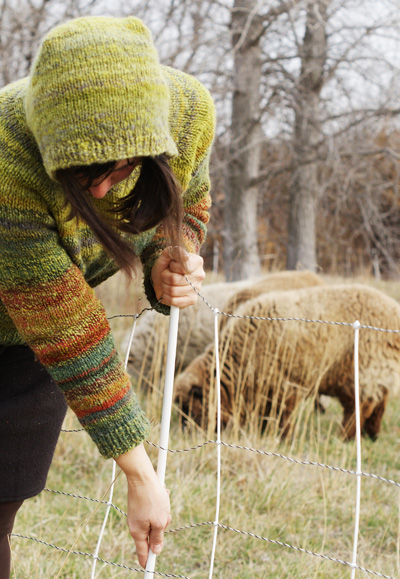 Find Gauge Knit a swatch in a needle size that seems appropriate to your yarn. If you like the fabric, use it to calculate your gauge; otherwise, try different needles until you’re happy. Mostly, you’ll use the gauge to cast on for the hood, and the pattern resolves itself from there. Hood Tip: Your number of increase rows will equal your number of sts per inch. (Just divvy them up roughly evenly over your allotted inches). Without turning work, pick up and knit 1 st through the top loop only of each of the slipped sts along the side; turn work, and knit back up side and across top; without turning work, pick up and knit 1 st through the top loop only of each of the slipped sts along the other side; turn work, purl to end. Work until piece is 8 - 9 inches from “seam,” including edging. 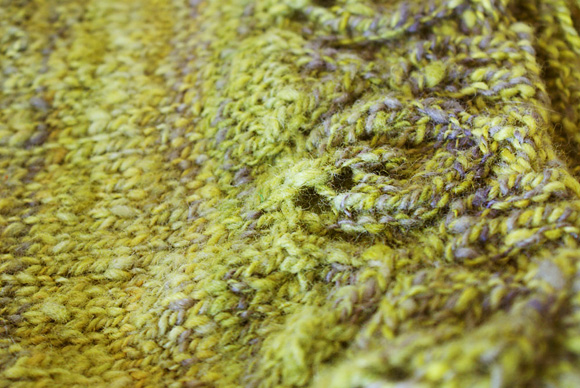
Yoke Inc before and after each marker every other rnd until yoke reaches 3-4 inches below your armpit, or longer for looser fit. Divide for Sleeves Torso Sleeves Kangaroo Pocket |
|
FINISHING |
| ABOUT THE DESIGNER |
|
|
|
Pattern & images © 2011 Nikol Lohr. Contact Nikol |